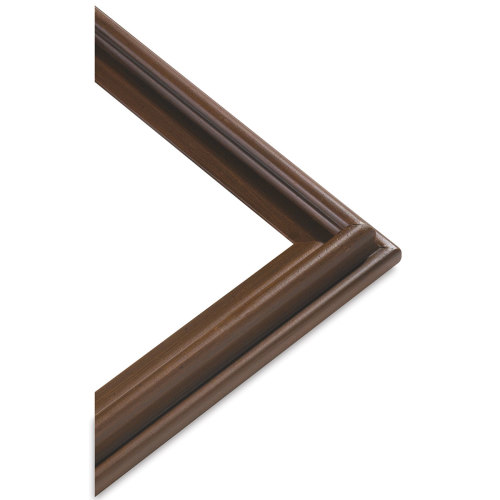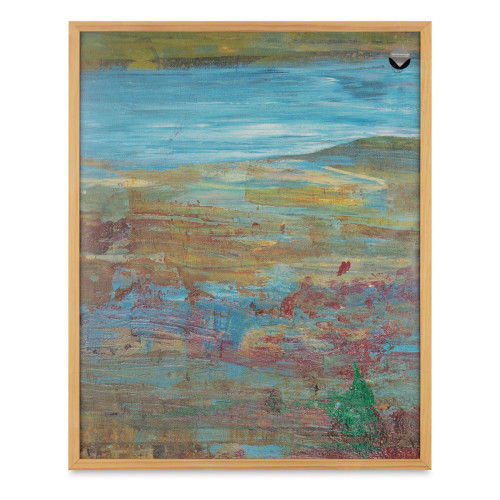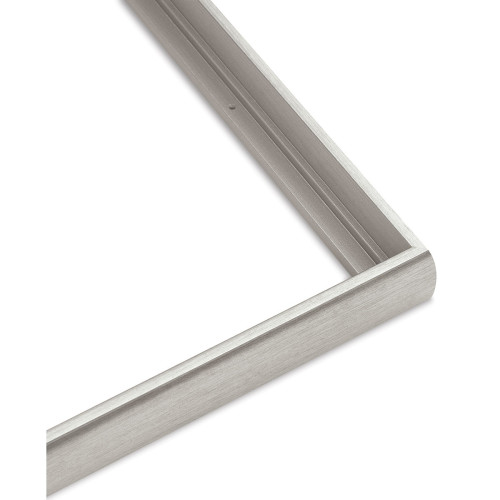Learning how to frame a painting is relatively easy when you know what type of frame you should get for your artwork, when you have the right tools and steps at hand. The steps for framing, hanging and displaying an artwork can vary depending on whether you’re framing a canvas or paper.
In this guide, we will provide you with all the information you need to know about framing paintings. We’ll start by discussing how to choose a frame that complements your artwork. Then we will walk you through the different ways to frame a painting. Finally, we’ll give you some tips on how to hang and display your painting. Let’s get started!
Disclaimer: Fine Art Tutorials is a reader supported site. When you make purchases through links on this site, we may earn a small commission at no extra cost to you.
How to choose a frame for your artwork
It’s important to choose a frame that will complement and draw attention to the artwork, whilst also making sure that it doesn’t overpower the piece.
When selecting a frame, you need to measure the height, width and depth of your artwork. This will help you determine the size of the frame that you need.

Some frames come with a mat or border. If your artwork is smaller, you may want to consider using a mat to enlarge the appearance of the painting. The mat can also help protect your artwork from dust and dirt.
If you’re framing an unvarnished work, such as a charcoal drawing or watercolour painting, we recommend using UV filtered glass to prevent colours from fading over time. Gallery frames usually come with glazings and backings and they occasionally come with matboards too.
There are a variety of frame materials and finishes to choose from when buying a premade frame, including wood, metal and plastic. Glazings also come in acrylic or glass.

Consider how a particular frame material or appearance could impact the aesthetics of the artwork. A wooden frame, for example, would go well with a landscape oil painting. A thin frame in a neutral colour would let a bold abstract painting sing, instead of appearing too overwhelming.
Types of frames
There are three main types of frames: open back canvas frames, gallery and floater frames.

Canvas frames, also called open back frames are sold as frame faces, usually without glazings and backings. These are perfectly suited for framing canvases and panels. Using canvas offset clips, stretched canvases may be easily integrated into any standard picture frame, however. This excludes frames with a narrow rebate depth. Glazings, mounts, mats, and backings are not required when purchasing a canvas or panel frame.

Gallery frames are designed to showcase an artwork and typically have a thin metal profile with a mat and glazing. They come in a variety of shapes and sizes. Prints and paper artworks are conventionally framed in gallery frames, however, some will accommodate canvases too.

Floater frames are used to frame canvas paintings without covering up the sides of the painting. They’re made from a thin piece of wood or metal and give the impression that the canvas is floating between the frame. The canvas is supported by the frame stretcher bars at the back.
Here’s an example of a canvas panel in a floater frame, featuring one of my seascape paintings. Check out our guide on how to choose a frame to see all the potential options and decide which will suit you.
What supplies do you need to frame a painting?
Now that you know how to choose a frame, it’s time to learn what supplies you need to actually frame the painting. This will vary depending on the painting surface and medium.
If you are framing a canvas, all you need is a wooden or metal frame, some wire for hanging, and some nails or screws.
For paper paintings, you will need a matboard and backing board in addition to the frame. The matboard should be slightly larger than the artwork itself. You can also use an acid-free foam or cotton core as your mounting board if you want to add extra protection for your artwork. Note that most gallery frames sold by suppliers like Blick, will come with these extras, so you can just frame the painting by inserting the paper behind the glass.
Premade frame
One option is to choose a premade frame, if your artwork adheres to standard canvas or paper measurements.
Gallery frames are best for prints and painting on paper. A great option that is both high quality and budget friendly, is the Blick Gallery frame. This frame comes in wood and metal and also accommodates for surfaces with thicker profiles, for example panels and canvases.
Get a classic wood frame for your canvas, a metal frame or a contemporary looking floater frame. Check the prices on Blick, they have hundreds of options when it comes to styles, materials and frame sizes.
Matboard
When it comes to matboard, there are a few things to consider. The main function of the matboard is to provide a border for your artwork and create a space between the painting and the frame. This helps to protect the painting and also enhances its appearance.

There are two types of matboard: conservation and regular. Conservation matboard is usually made of 100% cotton and is acid-free. It won’t yellow or degrade over time, making it the best option for framing paintings that will be displayed for a long period of time. Regular matboard is made of wood pulp and is not acid-free. This type of board will eventually yellow and become brittle, so it’s not recommended for long-term displays.
You can buy matboard to cut yourself, or buy pre-cut matboard. Matboards are exclusively used for framing paper, like prints. For works on canvas, matboards aren’t necessary.
Mounting board
Mounting board is used as a backing board for the artworks on paper to provide extra surface stability. The backing board serves as an extra layer of protection for your painting. Some mounting boards are self adhesive. Make sure to look for a board that is acid-free and made from cotton if you are looking for museum quality option.
Glazing materials
When it comes to glazing materials, there are two main types: glass and acrylic. Glass is the most common material for glazing and is available in a variety of thicknesses. It’s important to get a glass that has a UV filter to protect your artwork from fading.
Acrylic is a newer type of glazing that is becoming more popular because it’s shatterproof and lighter weight than glass. However, acrylic doesn’t have as many options when it comes to thicknesses and UV filters.
Gallery frames come supplied with different types of glazing, so you don’t need to worry about buying this separately unless you are customising your own frame.
Framing tools and accessories
- Point drivers: use these to secure prints and paper paintings inside a gallery frame.
- D rings: these are metal rings that artists attach to the back of the frame to hang artwork on a wall.
- Wire for hanging: this is a thin wire that loops through the D ring and helps to keep the frame level. This picture hanging kit comes with wire and screws.
- Canvas offset clips: these are small metal clips that help to keep the canvas in place within the frame.
- Mat cutters: these allow you to customise the size and shape of your matboard, you won’t need this if you get pre-cut mats.
- Double sided tape: use this to secure a backing to a canvas frame.
- Frame backing paper: this acid-free paper that protects the back of a canvas from dust, it’s an optional extra.
- You can get a kit, like this frame backing kit that comes with backing paper and framing hardware.
How to frame a canvas painting: Step by step
- Place the frame face down on a clean surface with the canvas inserted face down into the opening.
- The back of the canvas should be sticking out of the frame. Use offset clips to secure the canvas in place.
- Place the offset clips around about every 6 inches around the back of the artwork to ensure that it is fully supported. If the canvas is larger, you could place a clip every eight inches.
- Drill a screw in the hole of each canvas offset clip.
- The next optional step is to add a backing to the canvas to protect it from dust. Use double sided tape, tape the outer edge of each side of the back of the frame.
- Attach the frame backing paper to the back of the frame over the tape. Run your hand along the tape to ensure that it has stuck properly. Then trim the excess of the paper off, so the paper isn’t visible from the front of the frame.
- Make a small hole in the back of the paper, to allow for changes in temperature and humidity.
How to frame a canvas in a floater frame: Step by step
- Place the canvas in the opening of the floater frame facing up. The back of the canvas will be resting in the rebate on the back of the stretcher bars.
- Place the frame and canvas face down on a clean surface. Then use a drill to secure the canvas in place with screws through the holes in the stretcher bar.
How to frame a painting on paper: Step by step
Here’s how to assemble your own gallery frame. All you need is a wooden frame, some metal brackets, matboard, mounting board and glazing materials. However, if you bought a gallery frame, all these materials will be provided.
- Cut the matboard to the size of your painting using a mat cutter, or use a pre-cut matboard.
- Mount the painting onto the mounting board with adhesive or tape.
- Insert the glazing material into the frame.
- Place the painting on the matboard into the wooden frame.
- Add the backing and secure in place with a point driver.
- Secure the D rings and wire to the back of the frame and attach it to the wall with screws or nails.
Hanging your artwork
There are a few things to consider when hanging your art:
- The center of the artwork should be at eye level or slightly lower
- The center of the frame should be even with the center of the picture wire or hook
- Make sure there is enough space between each piece of art and the walls to create an illusion of depth
- Use a level when measuring and marking where to hang your frame
Hang the painting on the wall, either with command strips or with D rings. First, drill the D rings onto the back of the frame. Then, measure the wire and loop the wire through the D rings. Finally hang with a hook on the wall.
Do you need to frame a canvas?
You may not need to frame your canvas if you have purchased a gallery-wrapped canvas. A gallery-wrapped canvas is a canvas that has been stretched and glued or nailed to a wooden frame from the back. So the sides will appear as plain canvas, however some artists choose to paint the sides. This type of frame is ready to hang on your wall.
Framed artwork display tips
When displaying framed artwork in your home, you want to create a cohesive and stylish look. Here are a few tips to help you:
Group artwork together by size, color or subject matter and hang artwork at different levels for interest. Another option is to create an interesting gallery wall with a mix of framed art, mirrors, photographs and sculpture. Think outside the traditional rectangular frame and try using a square or oval frame for an eclectic look. Use wide matboards for small artworks and floater frames to create a contemporary look. You could also mount watercolour paintings or drawings onto panels, then frame in a floater frame or canvas frame to bring a new dimension to the artwork and make it more of a feature on the wall.
Tips to protect and conserve the artwork
Artwork should be hung on a wall that is away from heat, like radiators or fireplaces. Make sure to place artwork away from direct sunlight. Of course, you can hang your painting in a room with lots of natural light, but if there’s a wall that gets a lot of direct sunlight, this can cause certain pigments to fade over time. Mitigate the risk of fading by making sure the artwork has been painted with lightfast pigments, by protecting with UV resistant varnish or framing behind UV filter glass.
How to clean an artwork
Dust artwork with a clean soft brush to remove dust and dirt. Avoid rubbing the surface with a cloth as this could damage the surface. Another thing to avoid is using household cleaning products on the surface of a painting.
For restoration reasons, usually the layer of varnish on acrylic and oil paintings is removable. Depending on the varnish used, it can be removed with a solvent like turpentine. This is not something that you should need to do often, usually layers of varnish that have collected dust and dirt over the years are restored infrequently.
If you’ve found anything on this site especially useful, you can make a donation to me through PayPal. I take a lot of time to research and write each topic, making sure each tutorial is as detailed as possible and I make all my content freely available. Any small donation (even the price of a cup of coffee!) can help me to cover the running costs of the site. Any help from my readers is much appreciated :).
Follow the link in the button below to support this site.


I like that you talked about how it is essential to pick a frame that would complement and draw attention to the artwork. We have a painting in our living room and it seems its current frame is already broken. We need a new frame, so we are thinking of asking for an art frame glass replacement service.